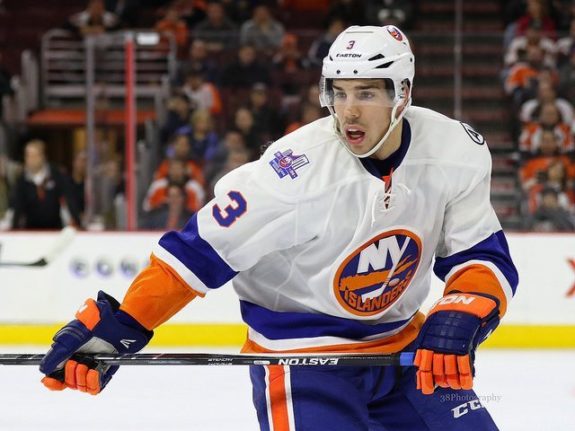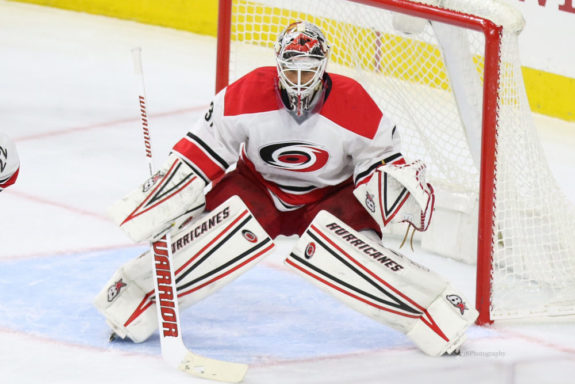Since the end of the 2017 Stanley Cup playoffs, the Calgary Flames have been busy. Aside from perhaps Vegas Golden Knights general manager George McPhee, no National Hockey League executive has been as active as Brad Treliving in trying to improve his club.

As the dust from a busy month of moves settles, the Flames are a much different team than they were at the end of the playoffs. But are they better?
Winter Tinkering
Treliving’s busy summer was preceded by some mid-season roster tinkering. The Flames had seemingly turned a corner in mid-November and found their stride, but Treliving took a page from the book of legendary former GM Cliff Fletcher and began to make moves while the team was rolling along and racking up the points.
Not content with his team’s defensive depth, Treliving added Michael Stone via trade with Arizona and Matt Bartkowski via free agency. Those moves bumped Dennis Wideman and Jyrki Jokipakka to the sidelines, at least until Jokipakka was packaged off to Ottawa for Curtis Lazar. The mid-season defensive moves slotting in a pair of low-event defenders in place of a couple shakier presences in the defensive zone, while Lazar’s addition gave the Flames a bit more depth – albeit depth in the press box.
Summer Overhaul
The disappointment of being swept in the playoffs led to a lot of introspection in the Flames hockey operations department. Rather than making some rash moves, they made a few simple assessments and then went about fixing their perceived issues. Based on the moves they’ve since made, the issues they identified were: (1) a lack of confidence in their starting goaltending, (2) a big drop-off between their three defensive pairs, and (3) a lack of speed among their depth forwards.
Goaltending: The Flames acquired Mike Smith from Arizona, Treliving’s former club, to be the new number one goaltender. Smith’s acquisition likely led to Chad Johnson, whose expiring rights were traded to Arizona for Smith, heading to the free agent market. Primarily, this move seems to have been about replacing Elliott, who was not great in the playoffs, with a player that Treliving knows very well. A subsequent trade acquired Eddie Lack from Carolina with half of his salary retained, buying low on a goaltender who seemed out of his depth as a starter in Carolina but had a reptuation as a strong backup in Vancouver.
Defensive Pairs: The team’s big move was acquiring Travis Hamonic at the NHL Draft, which anchors the back end with two strong pairings – likely Mark Giordano with Dougie Hamilton and Hamonic with T.J. Brodie. The subsequent re-signing of pending free agent Michael Stone beefs up the third pairing to a big extent, giving the team five strong defensemen and eliminating the giant drop-off between pairings throughout games. As of now, the thought is Stone will play with one of Brett Kulak or Bartkowski next season.
Forward Depth: Lance Bouma was bought out of the remaining year of his contract while Alex Chiasson did not receive a qualifying offer. Chiasson still may return, as his non-tender was likely more about his arbitration status than anything else, but these two moves open up some spots for the young forwards potentially graduating from the American Hockey League’s Stockton Heat. Mark Jankowski and college signing Spencer Foo are two prominent names likely now in contention for NHL jobs.
Solving Problems?
The definite big improvement for the Flames was on the blueline. In no uncertain terms, the Flames now boast one of the deepest, most talented three pairings of blueliners in the NHL. The newfound depth should help provide consistency at even strength, but it might also provide an improvement in Calgary’s penalty killing now that the puck movement while a man down won’t be entirely dependent on Mikael Backlund and Michael Frolik. (Losing Bouma will likely also help the penalty kill.)

Shedding some depth forwards in favour of graduating some new faces carries some risk, but the newcomers are at least somewhat familiar with Glen Gulutzan’s systems and they should provide speed and skill in their limited minutes. The Flames’ offensive production will likely still be skewed towards their top two forward lines, but at least now it’s more likely that the remaining groups should be able to push the pace and not give the opposition a reprieve.
The goaltending moves are a bit more of a gamble. Smith played well in stretches last season, but still had iffy underlying numbers on a pretty bad team. Meanwhile, Lack spent two years trying in vain to cement himself as a starter in Carolina. He may do better with a smaller, more defined role in Calgary, but he seems like a one year stop-gap so that the Flames can give Jon Gillies another season to mature in the AHL. Neither goaltending move seems like a slam-dunk improvement the way adding Hamonic and retaining Stone were.